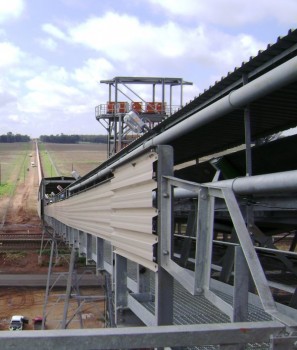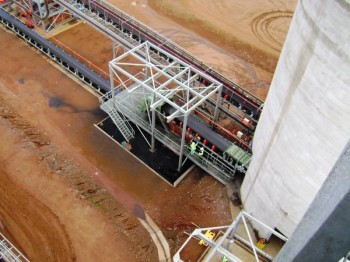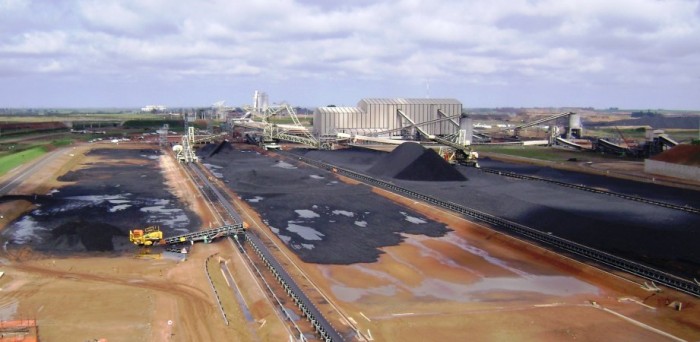WEG commissions longest VSD-driven conveyor in Africa
WEG successfully commissioned the longest VSD-driven material handling solution in Africa for Anglo Thermal’s Zibulo Coal Mine near Witbank in Mpumalanga.

Photo: WEG
The conveyor transports coal from Zibulo mine to the Phola coal processing plant. The user friendly conveyor system reduces the environmental impact while saving energy. The association with Anglo Thermal gave WEG a keen insight into its requirements, enabling the company to provide this application-relevant, customized solution to maximize uptime and productivity, and minimize maintenance.
The physical length of the Zondagsfontein conveyor presented numerous unique challenges. The length of some 16 km and a designed tonnage of 1750 tph required Zest to place drive pulleys at both head and tail. The head drive pulleys are driven by four WEG 500 kW VSDs and motors whereas the tail is driven by only two. This Master/Follower co-ordination of head and tail torque and speed control uses fieldbus communication over fiber optic cable. The controls also had to be integrated into the customer automation system and structure.
WEG was responsible for programming the VSD/motors combination to provide full compatibility with the customer system. This means that the central control room receives a number of feedback signals, such as speed, torque, current, power and alarms from the motors and VSDs.
Starting and running control was a highly complex undertaking. During the first start-up, the tail portion of the belt remained stationary for a full two minutes after the head was started. All six motors run at low speed for about a minute at start-up to allow tensions in the conveyor belt to equalize before the conveyor could be accelerated to full operating speed.

Photo: WEG
During normal start-up, the four head drives must operate with closely matched torque, as must the two tail drives, but the head and tail torque and speed differ considerably. So, once the belt stretch has stabilized, all six drives must match torque and speed precisely. The torque output from a 500 kW motor is potentially huge, so it is extremely important to control torque levels and load-sharing between the different motors accurately. The WEG design ensured that these complex requirements were achieved.
Subsequent to this first start up, the normal operation requires the head pulley to start first and with the tail pulleys starting twenty second later. During this time the speed is limited to around 70 rpm to ensure that the load is balanced and after five minutes accelerates to its full speed of 4.7 meters per second.
Applying this manner of VSD control to a conveyor belt results in the best possible conveyor control. One achieves minimized belt stress and mechanical wear with optimized product delivery. It also results in a longer belt lifecycle and minimum electrical power consumption. The industry is becoming increasingly conscious of the need to reduce energy consumption because of the current energy supply crisis.

Photo: WEG
The WEG CFW-09 Series of VSDs incorporates the world’s most advanced drive technology for three-phase AC induction motors. The Vectrue Technology ™ enables the new generation WEG inverters to combine V/F, sensorless and closed loop vector (with encoder) control techniques in one product. The true open loop vector controls allow for high torque and fast, dynamic response, and the self-tuning means that there is automatic drive set-up to match the drive to motor and load in vector modes.
The VSDs are equipped with dead time compensation technique, thus avoiding motor instability and providing increase of torque at low speeds.
The system is running well and the mine is enjoying an increased level of safety on site. In terms of energy expenditure, the mine recovered the money invested in the installation for the conveyor in record time, resulting in major savings for the joint venture, while also reducing the operation’s carbon footprint. A second conveyor belt was commissioned on this site making use of four WEG 750 kW VSDs in a master/follower configuration. The calculated absorbed power is similar to that of the other installation with the only difference being the belt length.
News Categories
- » NEWS HOME
- » Automation & Robotics
- » Industry 4.0
- » Material Handling
- » Sensors
- » Quality & Testing
- » Machine Vision
- » Laser & Optics
- » Metalworking
- » Motion Control & Drives
- » Hydraulics & Pneumatics
- » Process Industry
- » Renewable Energy
- » Agriculture
- » Home & Office Furniture
- » Environmental Tech



